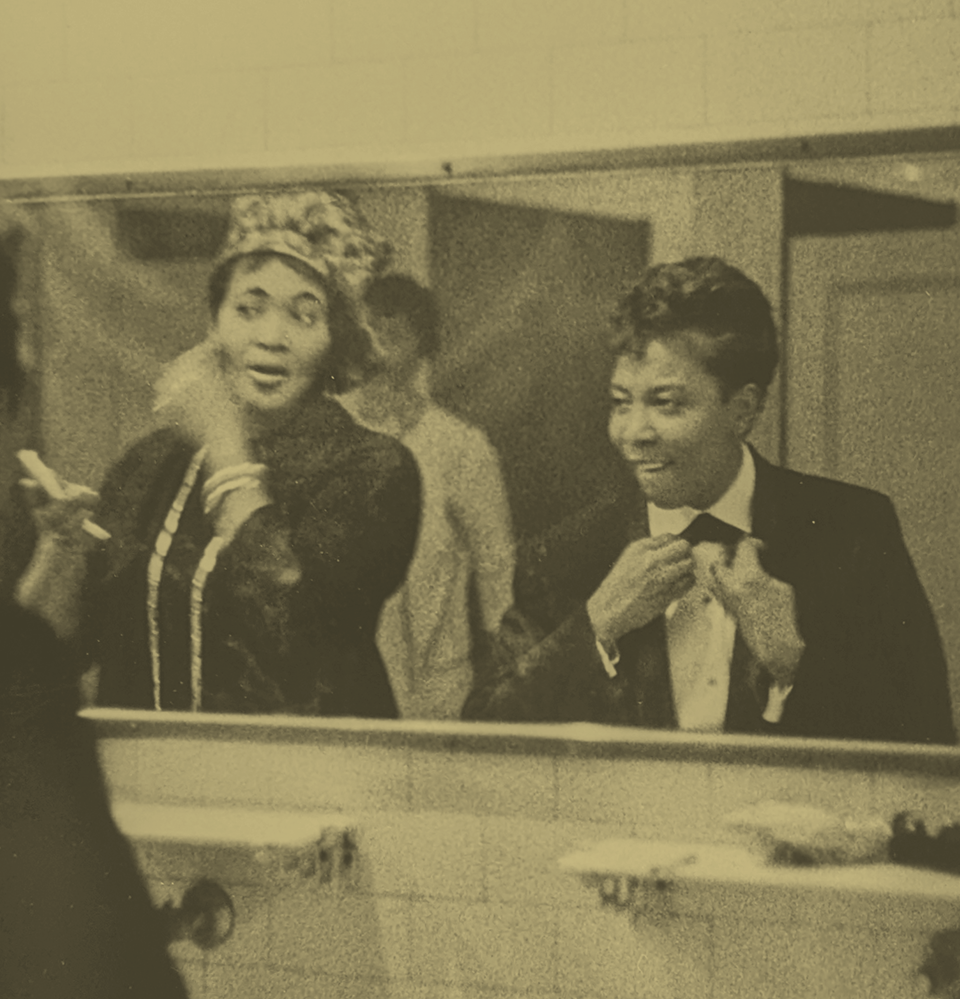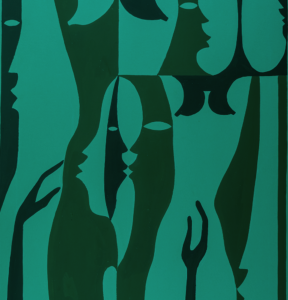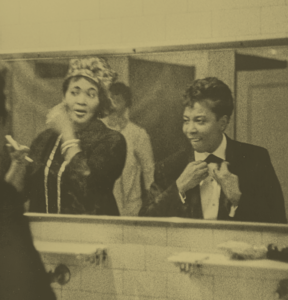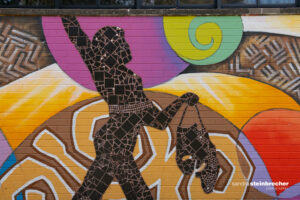Ain’t Done Tryin Yet: On Ferrill’s Gaze
zakkiyyah najeebah dumas-o’neal
i come to the city
for protection
and to witness the thick transactions
of women
and women
and dance with my head
my turns are calculated
to end on the right foot
to subdue the hip movements
the city fumes with expectations
and the smells of women
wanting women.
i been in love
six times in the last six months
and ain’t done tryin yet
-Cheryl Clarke
EMERGENCE: Intersections at the Center is a radical undertaking with the intent to re-imagine and re-contextualize South Side Community Art Center’s art collection through a queer reading, as it appears through the works of several Black artists in our collection. While queer encompasses a wide spectrum of identities, many of those artists, not all—at least from a contemporary reading—are identifiable as gay men, while some remain, and rightfully so, illegible and without categorization. In consideration of the deliberate choice to not be defined by the limitations of categorization, i still find myself longing for more lesbian and queer Black women identities within the collection and archive. Clarke’s poem above, i come to the city, excites and triggers my longing for that which feels lost, or rather just hasn’t been uncovered—yet. This work and its reference to city life, desire, wanting, and lesbian socialization brings me to Chicago as a site, historically and presently, as one with a vibrant Black queer women’s history of place-making and aliveness. To take this up, I’m considering the liminal space in EMERGENCE where documentation attempts not only to make up for this loss but also to bring forward what Kara Keeling names as “the production of poetic knowledge,” as it appears in the work of Mikki Ferrill.
“The role of poetic knowledge in this radical imagination is to disrupt the transparency and authority of present perceptions, to “take us to another place, envision a different way of seeing, perhaps a different way of feeling.” [1]
I turn to poetics here as a means of interpreting and meditating on a photograph by Mikki Ferrill, Untitled Chicago from 1965, which depicts two women figures in a bathroom experiencing an intimate moment—with the thought that this image offers a different way of feeling through my own act of seeing, and potentially those who view it, with slowness.[2] What I love most about Ferrill’s memory of making this image in the bathroom that night is her emphasis on the flirtation taking place between the two women:
“I thought it was obvious. Actually, the one straightening her tie is making a move on the one powdering her face… it was a flirtatious situation…”
She then added, “ I don’t know what happened after that because I left.”
Ferrill specified the scene took place “at a Halloween gay ball at the Trianon on Cottage Grove…” [3] It’s important to settle on the site–specificity of Ferrill’s account, given that she positions the South Side as a site for queer night life, desire, and expanded ways of being. In comparison to many of the other works on view, this image stands to “disrupt the transparency and authority of present perceptions,” referred to by Keeling, that might lead us into that wanting, desire, and Black queer women–centered belonging. Beyond the timing and swiftness of Ferrill’s sharp and perceptive eye, I ask of myself and the viewer: What happened after Ferrill left? Who are the women outside of the context of the party? What lives do they lead in public? What are their lives in private? How many times have they themselves been in love—with other women? Thinking of Clarke’s i come to the city, Ferrill’s striking image of the two women in a bathroom on the South Side of Chicago that night reveals a world in which Black women wanting women could be a portal into a life fulfilled, but also provides evidence of this wanting and possibility. “City life” provided—and still does—spaces through which queer folks could project themselves otherwise, outside of the norms of heteronormative society. This is most evident through the poetics of gazing—the figure gazing in the mirror at herself while being gazed upon by the one fixing her tie. It’s truly the normalcy and effortlessness, the matter-of-factness of the forms of gazing taking place that also register for me Ferrill’s own comfortability and experience occupying queer and lesbian–inclusive spaces. What I find most compelling is that Ferrill’s photographic gaze commands a refusal of erasure, and a queering of time itself.
To understand Ferrill’s access to this scene, it is helpful to know that she was born in Chicago and was part of a network of Black photojournalists working on Chicago’s South Side in the 1960s and 70s, notably during the height of the Black Arts Movement. She worked for such publications as Ebony, Downbeat, and Chicago Defender. Ferrill is most known for her energetic and poetic photo documentation of The Garage, an improvised club and gathering space located at 610 East 50th Street in Chicago [3]. The Garage had a reputation for holding space for a wide spectrum of Black identities to be expressed, which of course encompassed varying queer identities, and Ferrill was there with her camera every Sunday for ten years to create images of closeness, intimacy, and Black movement. Ferrill shares her observation of The Garage:
“The funny thing about The Garage was it was just a place to be and be free. And men would dance with each other, and they wouldn’t have to be homosexual. It was just the way you felt. If somebody was up there dancing and you wanted to dance with them, you danced with them, and it wasn’t looked upon as anything but having fun and expressing your musical self. So, it was everybody-friendly… All accepting. It was all accepting. You just had to behave correctly.” [4]
Sites of entertainment and nightlife in the city are known to offer a place for queer inclusive gazing and communal celebrations to take place. Already in the 1920s, such sites offered a space for queer–inclusive gazing and communal celebrations. Thaddeus Russell’s The Color of Discipline: Civil Rights and Black Sexuality, state that the origins of Black queer life in the United States are to be found in Harlem and the “Black Belt” of Chicago [5]. Blues singers, such as Gladys Bentley, Alberta Hunter, and “Ma” Rainey, who were all popular at the end of the 1920’s, often performed in Chicago and had recorded numerous sexually explicit songs that included descriptions of homosexual acts [6]. I explicitly call, and end on Bentley, Hunter, and Rainey to signify the history of Black queer and lesbian women taking up space and making space on the South Side of the city, circling us forward, and back to Ferrill’s image.
Keeling, Kara. “Queer Temporality, Black Political Possibilities, and Poetry from the Future (of Speculative Pasts).” Queer Times, Black Futures, New York University Press, New York, 2019, p. 84.
Kemi Adeyemi reminds us of the relationship between slowness, Black queer women’s physical right to space within the city, and their articulation of “slowness as a critical rubric of belonging therein…” in her essay “The Practice of Slowness: Black Queer Women and the Right to the City.” GLQ: A Journal of Lesbian and Gay Studies 25: 4 (2019), 545–567.
3. Interview with Mikki Ferrill by Rebecca Zorach, September 27, 2021.
4. Ibid.
5. Thaddeus Russell, “The Color of Discipline: Civil Rights and Black Sexuality.” American Quarterly 60:1 (2008), 108.
6. Tristan Cabello, “Queer Bronzeville by Tristan Cabello,” Outhistory: It’s about Time, https://outhistory.org/exhibits/show/queer-bronzeville. Sandra Lieb, Mother of the Blues: A Study of Ma Rainey(Amherst: University of Massachusetts Press, 1981); Hazel Carby, “It just be’s Dat Way Sometime: The Sexual Politcs of Women’s Blues,” Radical America 20:4 (June-July 1986), 9–22; Lilian Faderman, Odd Girls and Twilight Lovers: A History of Lesbian Life in Twentieth Century America (New York: Penguin Books, 1992), 74–75.






